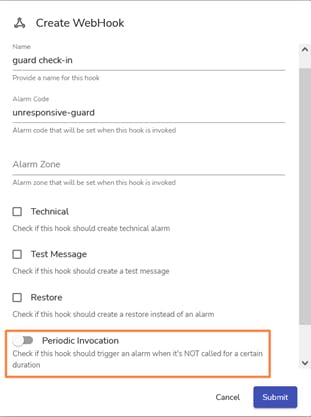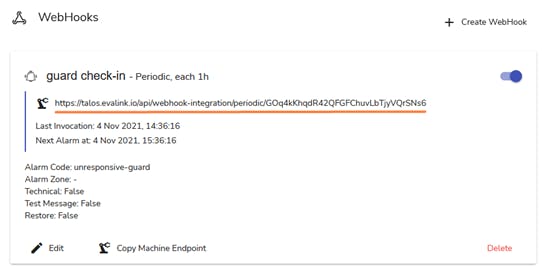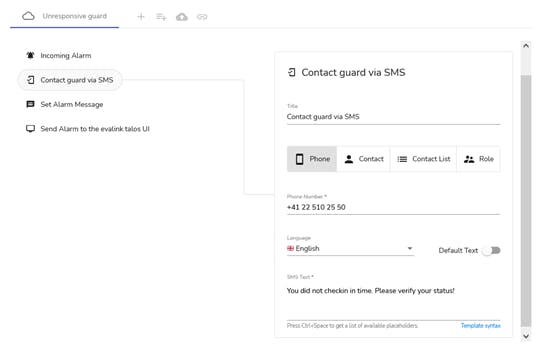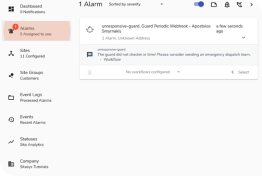- Guide
Tutorial: Periodic WebHooks - Automatic guard status verification
This article will discuss configuring evalink to expect a periodic signal through a WebHook. If the message does not arrive on time (the WebHook is not invoked within the time limit), an alarm will be sent, triggering the corresponding workflow.
This feature is particularly useful for security guards who have to report that everything is okay periodically. A single failure to report can trigger an alarm that eventually results in an emergency intervention team being dispatched.
"Periodic WebHooks" are based on the WebHooks Integration of the evalink marketplace, which needs to be enabled in the Integrations tab in your Company.
After enabling the integration, go to your Site. From the Integrations tab, create a new WebHook.
Specify a name for the WebHook (in our example, "guard check-in") and the Alarm Code that will be sent in case of a timeout (in our example, unresponsive-guard).
Do not forget to enable the option Periodic Invocation (marked orange in the picture below).

Enabling the Periodic Invocation will allow you to set the "Periodic Interval" and select if the timer needs to start immediately.
The “Periodic Interval” is the maximum timeout between WebHook calls. A timer is started each time the WebHook is called; if the new call arrives within the “Periodic interval,” the timer is reset. If not - an alarm is triggered.
The option "Start Timer Immediately" enables you to choose if the countdown timer starts immediately or after the first invocation of the WebHook.
In our example, we set an interval of 1 hour and choose to start the timer immediately.

After saving, the WebHook is created. We can see the details and the endpoint URL, the URL that the guard will call to verify that everything is okay.

Depending on the guards' configuration and on-site equipment, the endpoint URL can be invoked using different tools. Some of the options are:
- mobile application with a shortcut on the guard's mobile phone
- SafeTracker device (more information on the integration in the evalink marketplace)
- Any device capable of invoking a WebHook request
The WebHook can be called directly by the guard (using a mobile application or an on-body device) or by a fixed device mounted on a specific location (e.g., an RFID reader next to an entrance).
Example
Let's now try an example of a simple Workflow that can take advantage of the periodic WebHooks.
In our scenario, a guard must periodically invoke the WebHook generated in the above steps. The invocation is happening using an RFID reader next to the entrance of the guarded building.
Failure to trigger the WebHook within one hour will result in an unresponsive-guard alarm processed by an automated workflow.
The workflow is rather simple: in case of receiving an unresponsive-guard alarm, we use the "Automated Actions" > "Twilio Send SMS".
The SMS is targeted to the guard, notifying them about failing to check in on time.

Next, we enter a relevant issue description for the Operator in the "Set Alarm Message" field.

Finally, we forward the alarm to the User Interface.



